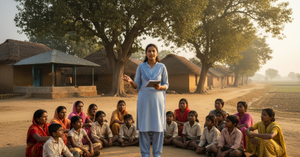Picture this: Your little princess spots her mama's dangly jhumkas swaying as she serves hot parathas for breakfast. Those tiny eyes light up with pure fascination, and before you know it, she's tugging at your dupatta, asking, "Mama, when can I wear pretty earrings like you?"
Does this sound familiar? Welcome to the beautiful, slightly nerve-wracking world of ear piercing for kids—a tradition as old as our grandmother's pickle recipes and twice as cherished!
When Tradition Meets Tiny Tots
Walk into any Indian household during festival season, and you'll see it – mothers helping daughters choose between their collection of jhumkas, grandmothers sharing stories about their first pair of gold studs, and little girls watching it all with wide, curious eyes.
This tradition didn't start with Pinterest boards or Instagram influencers. Our great-grandmothers were getting their ears pierced centuries ago, sometimes as part of religious ceremonies, sometimes simply because it was considered auspicious. In many Indian communities, a baby's first ear piercing was as significant as their naming ceremony.
But here's where it gets interesting – while the tradition remains, the approach has evolved completely. Today's parents navigate between honoring cultural practices and respecting their child's autonomy. The conversation has shifted from "when should we pierce" to "when does she want to pierce," and that's actually a beautiful change.
More Than Just Fashion – It's Our Heritage
Every Indian family has that one jewelry box. The one with compartments lined in faded velvet, holding pieces that smell faintly of sandalwood and old gold. These aren't just accessories – they're inheritance, protection, and identity all rolled into tiny, intricate designs.
Ear piercing in India is more than just putting on earrings. It’s a sacred ritual called Karnavedha, one of the important Samskaras that mark the milestones in a child’s life. This ceremony has been part of Indian culture for centuries, passed down through families as a symbol of blessing, health, and protection. Whether done when the baby is just a few months old or a little older, it’s always a moment filled with prayers, family gatherings, and lots of excitement.
What's fascinating is how this tradition has adapted to modern Indian families. Urban parents might skip the elaborate ceremonies but still feel the emotional pull when they see their daughter wearing her first pair of studs. That connection to ancestry doesn't disappear just because you live in a high-rise apartment instead of an ancestral home.
When Should Kids Get Their Ears Pierced?
Ask ten Indian mothers about the right age for ear piercing, and you'll get twelve different opinions – somehow, the math always works out that way in our families.
Traditional approach? Many families still follow the old practice of piercing within the first few months. The logic was simple – babies heal faster, don't fidget with the earrings, and it's "done before they know what happened."
Modern approach? Wait until the child asks for it. This camp believes in consent, even from little ones, and wants the experience to be positive rather than traumatic.
The practical middle ground? Around 4-6 years seems to be the sweet spot for many contemporary Indian families. At this age, children can participate in the decision-making process, understand basic care instructions, and handle temporary discomfort with some preparation and support.
But honestly, there's no universal right answer. Some families pierce at 6 months; others wait until 16. Both can be perfectly fine choices depending on your family's values and circumstances.
Making the Experience Comfortable and Safe
Ear piercing can be a big moment for both kids and parents. To make it a happy memory:
- Choose the right professional: Skip the stalls and head to a reputable piercing studio or pediatrician. Many Indian cities now have specialized children's ear piercing services that understand both safety and cultural preferences.
- Timing matters: Avoid piercing during illness, right before big events, or during monsoon season when infection risks are higher.
- Quality jewelry is non-negotiable: Start with hypoallergenic metals like surgical steel or gold. Those gorgeous silver jhumkas can wait until the ears heal completely.
- Aftercare is everything: Teach your child to avoid touching their ears, clean them gently with prescribed solutions, and watch for any signs of infection.
Picking the Perfect Jhumkas
The beauty of starting young is watching their style evolve! Begin with simple, lightweight studs – maybe those adorable tiny flowers or classic gold balls that won't pull on delicate earlobes.
As they grow, introduce them to the wonderful world of Indian jewelry:
- Age 6-8: Small hoops, colorful studs, maybe tiny chandbali for special occasions
- Age 9-12: Light jhumkas, oxidized silver pieces, contemporary designs that match their school uniform
- Teenage years: The sky's the limit! Heavy Kundan sets for weddings, trendy ear cuffs, and multiple piercings if they're interested.
The Emotional Rollercoaster (For Parents!)
Let's address the parent anxiety because it's so real! One minute, you're excited about this milestone; the next, you're googling "ear piercing infection symptoms" at 2 AM.
The worry is natural and shows how much you care. But remember – millions of Indian children have gone through this journey safely. Trust the process, choose quality professionals, and focus on making it a positive experience.
Making It Special: The Celebration Factor
Why not make ear piercing a memorable family celebration? Some families plan special outings, let grandparents choose the first pair of earrings, or combine it with other cultural ceremonies.
Document the journey with photos, let them pick out a special outfit for the big day, and maybe plan a small celebration afterward. These moments become precious family memories that they'll cherish forever.
Conclusion
Ear piercing for young children in India isn't just about beauty or fashion – it's about connecting with our roots, celebrating femininity, and marking special moments in a child's journey.
Whether you choose to pierce at 6 months or 6 years, the key is doing it with love, proper care, and respect for both tradition and your child's comfort. Those tiny jhumkas aren't just jewelry; they're symbols of heritage, milestones of growth, and sparks of joy that light up little faces.








Be the first one to comment on this story.